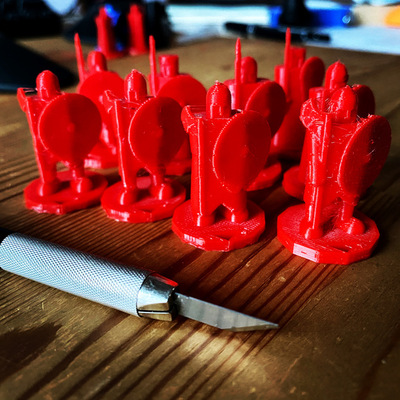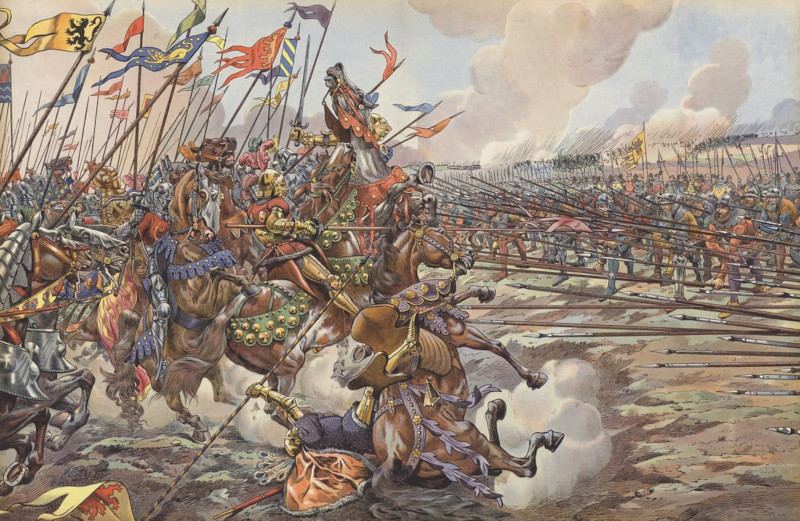
|
Lance Halberd Pike |
| 2022-02-22 |
Lance Halberd Pike

This post is a reaction to Alex Schroeder's post Pike Vs. Lance.
I am very interested by Alex reflections and the building of his Halberds and Helmets TTRPG and now his traveller-like version, named Halberts. Alex exposes his design decisions and there are plenty of things to learn from them.
But there is one thing I don't understand, it's his passion for the pike in his new game. I cannot imagine the fighter of an adventuring party wielding a pike, since, as soon as the adversary gets inside, the pike is defeated.
The pike is a formation weapon. Spear and halberd make sense in group combat and in single combat, the pike does not make sense in single combat.
Here is a rough comparison of weapon length, clearly the pike wins, but good luck maneuvering with it in a constrained space.
- ======> quarterstaff: six to nine feet
- =======> spear: six to eight feet
- =========> lance: nine to ten feet
- ====> goedendag: three to five feet
- ========> halberd: eight feet
- ==================> pike: eighteen feet
A pike is three times longer than a spear.
I took my copy of A History of the Art of War in the Middle Ages Volume Two (1278 to 1485) by Sir Charles Oman, and looked at book XI of the volume, the one entitled "The Swiss". I reproduce here a few quotes as they should teach us a lot, even if the book, last revised in 1924, has probably been superseded in a certain number of its theses. Still, it's an entertaining and easy read.
At first two quotes about the Swiss at the end of the Middle Ages. Who were those halberd and pike wielders? The portrait painted is not very flattering and we'll see below that it doesn't highlight all the flaws.
It would be wrong to indulge in reminiscences of the legendary William Tell, and to dream of the Confederates as virtuous yeomen merely defending an ancestral liberty against a feudal oppressor. Gessler's famous hat is as unauthentic as Tell's apple.
The primitive Swiss were a jealous, turbulent, and predatory race — they were already noted for their readiness to serve as the hired soldiery whom emperors took down to their Italian wars, and they were very troublesome neighbours to the rich abbey of Einsielden, whose abbots had been complaining of their cattle-lifting propensities for several generations.
p. 238
The Swiss of the fourteenth and fifteenth centuries have been compared with good reason to the Romans of the early Republic. In the Swiss, as in the Roman character, we find the most intense patriotism combined with a complete lack of chivalrous feeling or magnanimity, and a certain meanness and pettiness of conception which prevent us from sympathising with either race — however great its achievements.
p. 253
The halberd was the weapon of the first successes of the Swiss, especially Sempach, but soon, the pike became necessary.
The halberd was distinctly inferior to the pike as a means of keeping off cavalry, but was a formidable enough tool of war. Eight feet in length, with a heavy head ending in a sharp point, it had on its front a blade like a hatchet, and on its back a strong spike or hook. If the most ponderous, it was the most murderous of weapons. Swung by strong arms it could cleave helmets and plate-armour as no sword could do. It was the halberd whose edge dashed in the skulls of Duke Leopold's knights at Sempach, and struck down Charles of Burgundy (...)
Even after the pike became predominant, the halberd was still retained by some of the Swiss infantry, who had their regular place in the centre of the column, by the cantonal banner, which was placed under their charge. If the enemy succeeded in bringing the column to a stand, it was their duty to issue out by the side ranks or the rear ranks, which opened to give them egress, and to throw themselves against the hostile flank.
In repelling cavalry charges, however, the halberd, owing to its structure, was a far less useful weapon than the pike. The original adoption of the latter as a national weapon seems to result from the lessons of a disastrous fight near Bellinzona in 1422, when the Swiss, having too many halberdiers and too few pikes in their front, were broken by the men-at-arms of the Duke of Milan. But the halberd was liked by old-fashioned soldiers, and it was not till many years later that it was ruled that the pike must be the normal arm of the cantonal infantry. The older weapon was to be relegated to the reserve and banner-guard.
But all through the later fifteenth century, the long pike was supreme with its eighteen-foot ashen shaft and long ten-inch steel head. It was usually grasped with two hands widely extended, and poised to the level of the shoulder, with the point slightly sunk so as to deliver a downward thrust. Before the line projected, not only the pikes of the first rank, but those of the second, third, and fourth, an impenetrable hedge of bristling points.
p. 254 - 255
Dark Ages: shield wall, Middle Ages: knightly charges or longbow rain, Renaissance: hedge of pikes, ...
Alex points in No armour in Helmbarten! that studies had shown that the Swiss didn't like armour, crossbow, and pike (Spieß), since they were hard to use in close combat and were hindrances while pursuing and plundering.
Macchiavelli, quoted by Oman, confirms about the armour, but he underlines that it provides swift movement, from home to the battlefield, and from the march to the assault. The Swiss wanted to swiftly seize the offensive.
The power of swift movement was, as Machiavelli observed, in no small degree the result of Confederates' determination not to overload themselves with armour. Their light equipment was originally due to poverty alone, but was deliberately preserved on the discovery that a heavy panoply was incompatible with their national tactics. How often had dismounted knights been ruined by their incapacity to bear up long under the weight of their plate and mail! Sempach and Agincourt are only typical examples of a well-known general phenomenon. Wherefore the normal equipment of a Swiss pikeman or halberdier consisted of a steel cap and a breastplate alone, some adding arm-pieces or tassets. Even these where not in universal employment; many trusted the defence of their persons to their weapons, and came out in leather jerkins or buff coats.
p. 257
Speaking of Macchiavelli, let's remember he was one of those scholars fascinated by the ancients and their texts. Oman remarks and here we learn of another flaws of the Swiss:
At a time when the great struggle in Italy was serving as a school for the soldiery of other European nations, they (the Swiss) alone refused to learn. (...) The victories of the Swiss set every officer of capacity and versatile talent searching for an efficient way of dealing with the onset of the phalanx.
p. 274
Hadn't the Romans already dealt successfully with the phalanx?
The Spanish infantry of Gonsalvo de Cordova displayed once more to the military world the strength of the tactics of old Rome. They were armed, like the men of the ancient legion, with the short thrusting sword and buckler, and wore the steel cap, breast and back plates, and greaves. Thus they were far stronger in their defensive armour than the Swiss whom they were about to encounter.
When the pikeman and the swordsman first met in 1502, under the walls of Barletta, the old problem of Pydna and Cynoscephalae was once more worked out. A phalanx as solid and efficient as that of Philip the Macedonian was met by troops whose tactics were those of legionaries of Aemilius Paullus. Then, as in an earlier age, the wielders of the shorter weapon prevailed.
p. 275
The bearer of the longer weapon becomes helpless when his opponent has closed with him, whether the arms concerned be lance and halberd or pike and sword. The moment a breach had been made in a Macedonian or Swiss phalanx the great length of their spears became their ruin. There was nothing to do but to drop them, and in the combat which then ensued troops using the sword alone, and with little defensive armour, were at a hopeless disadvantage in attacking men furnished with the buckler as well as the sword, and protected by a more complete armour.
Whatever may be the result of a duel between sword and spear alone, it is certain that when a light shield is added to the swordsman's equipment, he at once obtains the ascendancy. The buckler serves to turn aside the spear-point, and then the thrusting weapon is free to do its work.
p. 276
I cannot resist copying here the note Oman added:
It is a curious fact that Chaka, one of Cetywayo's predecessors as king of the Zulus, set himself to solve this problem. He took a hundred men and armed them with the shield and the "short assegai", a thrusting weapon resembling a sword rather than a spear in its use. He then set them to fight another hundred furnished with the shield and the "long assegai", the slender javelin which had previously been the weapon of his tribe. The wielders of the shorter weapon won with ease, and the king thereupon ordered its adoption throughout the Zulu army. It was this change which originally gave the Zulus their superiority over their neighbours.
p. 276
The pike makes complete sense when used in formation. But a single fighting man brandishing a pike in front of his adventuring party? He'll probably have to use his sword very soon.
A ten foot pole makes for a good improvised pike, to counter an opponent in a narrow passage.
A lonely pike against a giant might make sense, to counter its reach, but the beast might steal the piece of wood and use it as a spit.
The halberd seems a more sensible weapon choice when not in formation. It's still used by the Swiss Guards in the Vatican (along with helmet and breastplate).
